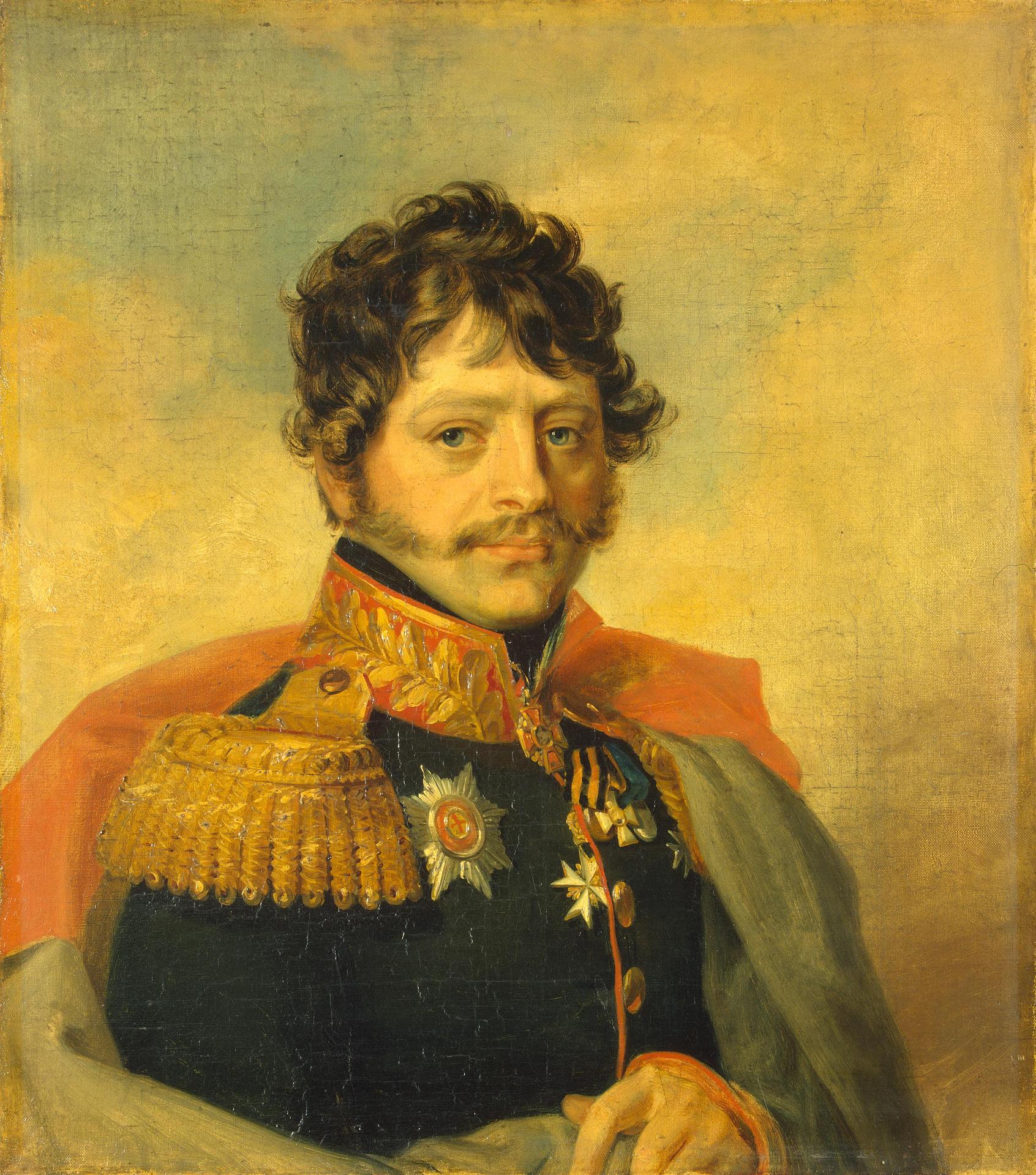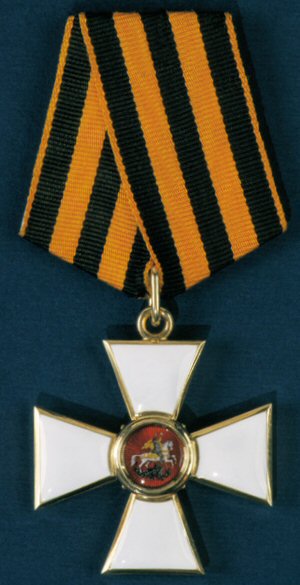|
Ivan Andreyevich Argamakov
Ivan Andreyevich Argamakov (Russian: Иван Андреевич Аргамаков; 15 December 1775, Osokino, Kostroma – 9 March 1820) was a commander of the Imperial Russian Army during the Napoleonic Wars. His final rank was major general, to which he was promoted in 1813. Life From a noble family in the Kostroma province, he studied in a nobles-only infantry corps. On 25 June 1793, at the rank of ''poroutchik'' (lieutenant), he was attached to the 10th Ingermanlandski Hussar Regiment. On 31 July 1794, beneath the walls of Vilna, he received a baptism of fire in a battle between Russia and the Polish–Lithuanian Commonwealth. He was promoted to captain the same year. On 2 December 1805, in the 16th Tver Dragoon Regiment, he fought at the battle of Austerlitz. On 29 June 1806, now commander of the same regiment, he fought in Moldavia and Wallachia. He also distinguished himself in the Russo-Turkish War, notably in the siege of Brailov. On 12 December 1807 he was promoted ... [...More Info...] [...Related Items...] OR: [Wikipedia] [Google] [Baidu] |
Battle Of Berezina
The Battle of (the) Berezina (or Beresina) took place from 26 to 29 November 1812, between Napoleon's Grande Armée and the Imperial Russian Army under Field Marshal Wittgenstein and Admiral Chichagov. Napoleon was retreating back toward Poland in chaos after the aborted occupation of Moscow and trying to cross the Berezina River at Borisov. The outcome of the battle was inconclusive as, despite heavy losses, Napoleon managed to cross the river and continue his retreat with the surviving remnants of his army. Background Napoleon had fought his way out of Russia in the battles of Maloyaroslavets, Vyazma and Krasnoi. His plan was to cross the Berezina River at Borisov (in Belarusian Governorate General) in order to join up with his Austrian ally, Field Marshall Schwarzenberg at Minsk. As the central core of Napoleon's Grande Armée marched toward Borisov, however, Russian troops supported by Cossacks moved to block his battered force, reduced to 49,000 men under arms and 40,000 ... [...More Info...] [...Related Items...] OR: [Wikipedia] [Google] [Baidu] |
Russian Commanders Of The Napoleonic Wars
Russian(s) refers to anything related to Russia, including: *Russians (, ''russkiye''), an ethnic group of the East Slavic peoples, primarily living in Russia and neighboring countries *Rossiyane (), Russian language term for all citizens and people of Russia, regardless of ethnicity *Russophone, Russian-speaking person (, ''russkogovoryashchy'', ''russkoyazychny'') *Russian language, the most widely spoken of the Slavic languages *Russian alphabet * Russian cuisine *Russian culture *Russian studies Russian may also refer to: *Russian dressing *''The Russians'', a book by Hedrick Smith *Russian (comics), fictional Marvel Comics supervillain from ''The Punisher'' series *Russian (solitaire), a card game * "Russians" (song), from the album ''The Dream of the Blue Turtles'' by Sting *"Russian", from the album ''Tubular Bells 2003'' by Mike Oldfield *"Russian", from the album '' '' by Caravan Palace *Nik Russian, the perpetrator of a con committed in 2002 *The South African name for a ... [...More Info...] [...Related Items...] OR: [Wikipedia] [Google] [Baidu] |
Order Of St John Of Jerusalem
The Order of Knights of the Hospital of Saint John of Jerusalem ( la, Ordo Fratrum Hospitalis Sancti Ioannis Hierosolymitani), commonly known as the Knights Hospitaller (), was a medieval and early modern Catholic military order. It was headquartered in the Kingdom of Jerusalem until 1291, on the island of Rhodes from 1310 until 1522, in Malta from 1530 until 1798 and at Saint Petersburg from 1799 until 1801. Today several organizations continue the Hospitaller tradition, specifically the mutually recognized orders of St. John, which are the Sovereign Military Order of Malta, the Most Venerable Order of the Hospital of Saint John, the Bailiwick of Brandenburg of the Chivalric Order of Saint John, the Order of Saint John in the Netherlands, and the Order of Saint John in Sweden. The Hospitallers arose in the early 12th century, during the time of the Cluniac movement (a Benedictine Reform movement). Early in the 11th century, merchants from Amalfi founded a hospital in ... [...More Info...] [...Related Items...] OR: [Wikipedia] [Google] [Baidu] |
Louis Nicolas Davout
Louis-Nicolas d'Avout (10 May 1770 – 1 June 1823), better known as Davout, 1st Duke of Auerstaedt, 1st Prince of Eckmühl, was a French military commander and Marshal of the Empire who served during both the French Revolutionary Wars and the Napoleonic Wars. His talent for war, along with his reputation as a stern disciplinarian, earned him the nickname "The Iron Marshal" (''Le Maréchal de fer''). He is ranked along with Marshals Louis-Alexandre Berthier and Jean Lannes as one of Napoleon's finest commanders. His loyalty and obedience to Napoleon were absolute. During his lifetime, Davout's name was commonly spelled Davoust - this spelling appears on the Arc de Triomphe and in much of the correspondence between Napoleon and his generals. Biography Davout was born in the small village Annoux (Yonne) as the eldest son of Jean-François d'Avout (1739–1779), a calvalry officer and his wife (married in 1768) Françoise-Adélaïde Minard de Velars (1741–1810). He was of ... [...More Info...] [...Related Items...] OR: [Wikipedia] [Google] [Baidu] |
Battle Of Leipzig (1813)
The Battle of Leipzig (french: Bataille de Leipsick; german: Völkerschlacht bei Leipzig, ); sv, Slaget vid Leipzig), also known as the Battle of the Nations (french: Bataille des Nations; russian: Битва народов, translit=Bitva narodov), was fought from 16 to 19 October 1813 at Leipzig, Saxony. The Coalition armies of Austria, Prussia, Sweden, and Russia, led by Tsar Alexander I and Karl von Schwarzenberg, decisively defeated the ''Grande Armée'' of French Emperor Napoleon Bonaparte. Napoleon's army also contained Polish and Italian troops, as well as Germans from the Confederation of the Rhine (mainly Saxony and Württemberg). The battle was the culmination of the German Campaign of 1813 and involved 560,000 soldiers, 2,200 artillery pieces, the expenditure of 400,000 rounds of artillery ammunition, and 133,000 casualties, making it the largest battle in Europe prior to World War I. Decisively defeated again, Napoleon was compelled to return to France while t ... [...More Info...] [...Related Items...] OR: [Wikipedia] [Google] [Baidu] |
Battle Of Bautzen (1813)
In the Battle of Bautzen (20–21 May 1813), a combined Prusso–Russian army, that was massively outnumbered, was pushed back by Napoleon but escaped destruction, with some sources claiming that Marshal Michel Ney failed to block their retreat. The Prussians under General Gebhard Leberecht von Blücher and Russians under General Peter Wittgenstein, retreating after their defeat at Lützen were attacked by French forces under Napoleon. Prelude The Prusso-Russian army was in a full retreat following their defeat at the Battle of Lützen. Finally, generals Wittgenstein and Blücher were ordered to stop at Bautzen by Tsar Alexander I and King Frederick William III. The Russo-Prussian army was nearly 96,000 strong, but Napoleon had 144,000. Wittgenstein formed two strong defensive lines east of the River Spree, with the first holding strongpoints in villages and along hills and the second holding the bridges behind a river bend. Their left flank was anchored by the town of Baut ... [...More Info...] [...Related Items...] OR: [Wikipedia] [Google] [Baidu] |
Order Of Saint Anne
The Imperial Order of Saint Anna (russian: Орден Святой Анны; also "Order of Saint Anne" or "Order of Saint Ann") was a Holstein ducal and then Russian imperial order of chivalry. It was established by Karl Friedrich, Duke of Holstein-Gottorp, on 14 February 1735, in honour of his wife Anna Petrovna, daughter of Peter the Great of Russia. Originally, the Order of Saint Anna was a dynastic order of knighthood; but between 1797 and 1917 it had dual status as a dynastic order and as a state order. The Order of St. Anna continued to be awarded after the revolution by Grand Duke Kirill Vladimirovich, Grand Duke Vladimir Kirillovich, and Grand Duchess Maria Vladimirovna. Today, the Russian Imperial Order of St. Anna, awarded by Grand Duchess Maria Vladimirovna is recognized as an order of chivalry by the privately operated ICOC as a continuation of the pre-Revolutionary order, and has been approved for wear with military uniform by the Russian Federation, but not by some ... [...More Info...] [...Related Items...] OR: [Wikipedia] [Google] [Baidu] |
Order Of St Vladimir
The Imperial Order of Saint Prince Vladimir (russian: орден Святого Владимира) was an Imperial Russian order established on by Empress Catherine the Great, Catherine II in memory of the deeds of Vladimir I, Prince of Kiev, Saint Vladimir, the Grand Prince and the Baptizer of the Kievan Rus'. Grades The order had four degrees and was awarded for continuous civil and military service. People who had been awarded with the St. Vladimir Order for military merits bore it with a special fold on the ribbon – "with a bow". There was a certain hierarchy of Russian Orders. According to this, the First Class Order of Saint Vladimir was the second one—the first was the Saint George Order—by its significance. According to Russian laws on nobility, people who were awarded the Order of Saint Vladimir had the rights of hereditary nobility until the Emperor's decree of 1900 was issued. After this, only three first classes of the order gave such a right, the last ... [...More Info...] [...Related Items...] OR: [Wikipedia] [Google] [Baidu] |
Order Of St George
The Order of Saint George (russian: Орден Святого Георгия, Orden Svyatogo Georgiya) is the highest military decoration of the Russian Federation. Originally established on 26 November 1769 Julian (7 December 1769 Gregorian) as the highest military decoration of the Russian Empire for commissioned officers and generals by Empress Catherine the Great.Hurley, C. ''Russian Orders, Decorations, and Medals Under the Monarchy''. Harrison & Sons., Ltd., London. 1935. After the October Revolution in 1917, it was awarded by the White movement under Alexander Kolchak until their collapse in 1921. The order was revived in the Russian Federation on 8 August 2000 by Decree №1463 of the President of Russia. The current award criteria were amended on 7 September 2010 by Presidential Decree 1099. Statute of the Order of St. George The current Order of Saint George is awarded to highest and senior military officers for the conduct of military operations to protect the Mo ... [...More Info...] [...Related Items...] OR: [Wikipedia] [Google] [Baidu] |
Neman (river)
The Neman, Nioman, Nemunas or MemelTo bankside nations of the present: Lithuanian: be, Нёман, , ; russian: Неман, ''Neman''; past: ger, Memel (where touching Prussia only, otherwise Nieman); lv, Nemuna; et, Neemen; pl, Niemen; ; uk, Німан, ''Niman'' is a river in Europe that rises in central Belarus and flows through Lithuania then forms the northern border of Kaliningrad Oblast, Russia's western exclave, which specifically follows its southern channel. It drains into the Curonian Lagoon, narrowly connected to the Baltic Sea. It flows about , so is considered a major Eastern European river. It flows generally west to Grodno within of the Polish border, north to Kaunas, then westward again to the sea. The largest river in Lithuania, and the third-largest in Belarus, it is navigable for most of its length. It starts from two small headwaters merging about southwest of the town of Uzda – about southwest of capital city Minsk. Only , an eastward mea ... [...More Info...] [...Related Items...] OR: [Wikipedia] [Google] [Baidu] |
River Berezina
The Berezina or Biarezina ( be, Бярэ́зіна; ) is a river in Belarus and a right tributary of the Dnieper. The river starts in the Berezinsky Biosphere Reserve. The length of the Berezina is 613 km. The width of the river is 15-20 m, the maximum is 60 m. The banks are low (up to 0.5 m), steep in some areas (up to 1.5 m high), sandy, and the floodplain is swampy. Berezina freezes usually in the 1st half of December. Its main tributaries are Bobr, Klyava, Ol'sa and from the left and Hayna and Svislach from the right. The Berezina Biosphere Preserve by the river is on the |






